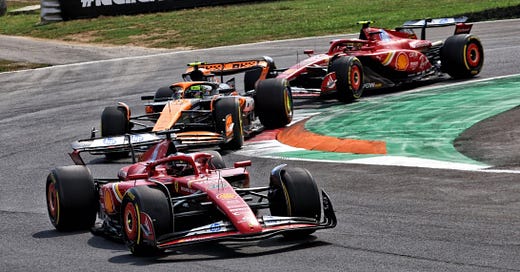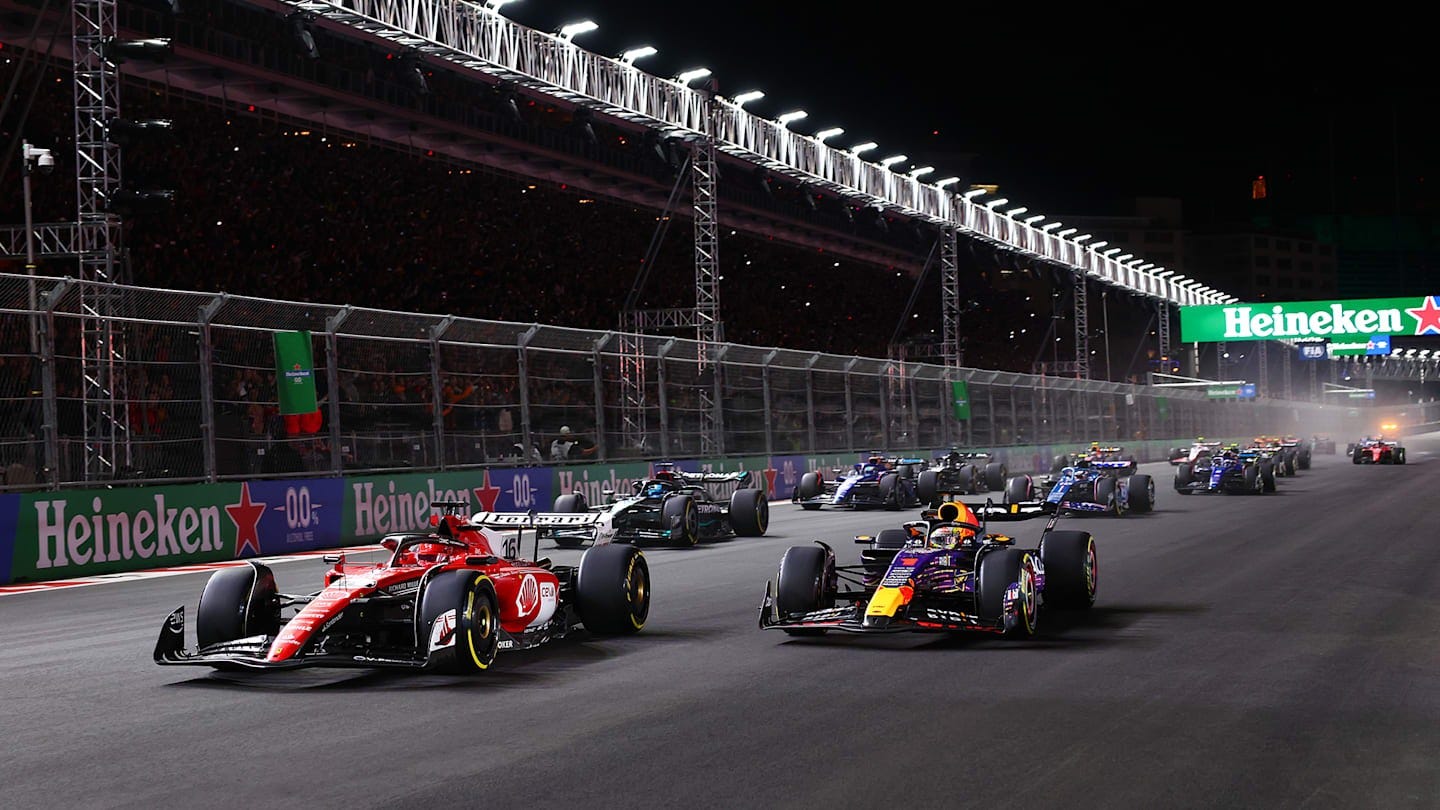Who owns the F1 teams?
With all the excitement on and off the track and new capital entering the sport in droves, who actually owns the teams at the end of the day?
Around in circles we go
Formula 1 is heading into its final race of the season in Abu Dhabi this weekend. While Max Verstappen has secured his fourth consecutive Driver’s World Championship, the circus has not stopped.
F1 just recently announced that it has reached an agreement in principle with General Motors to add a GM/Cadillac team to the grid in 2026 (notably without the direct involvement of Andretti anymore and at the low cost of an estimated $450m anti-dilution fee, plus all the additional investment in facilities, engine construction and personnel). All while Audi, who only just this year upped its ownership stake to 100%, is rumored to have sold a minority stake in the Sauber F1 outfit to the Qatar Sovereign Wealth Fund.
With all this back and worth, a question came to mind: Who actually owns all the F1 teams and why are ownership structures getting increasingly more complex?
Team ownership structures
Liberty Media has transformed the sport since buying the racing series in 2017 for $8bn (now valued at an estimated $22bn). Previously the sport was known to be the easiest way for billionaires to become millionaires. However, the increased commercialization focus of Liberty Media, the enormous success of Netflix’s Drive to survive and subsequent popularity spike in the lucrative U.S. market have caused a massive influx of revenue and capital to the sport.
The most fundamental change to the economics of the sport for teams was the 2021 introduction of a cost cap (initially $145m annually, now at $135m). The cap provided financial stability for the teams and prevented overspending, turning the notoriously cash burning entities into profitable ventures (80% of teams were profitable in 2023).
The cap moved F1 closer to U.S. sports like the NFL and NBA, making F1 more attractive to prospective investors. This has led to an influx of investments that has fundamentally changed the ownership structures of teams. Across the current 10 teams on the grid, only around 25-30% of the ownership is from pure car brands.
Let’s look at how this breaks down per team:
Scuderia Ferrari
Ownership:
Ferrari/Public after its 2015 IPO (67.09%), Exor N.V. (22.91%) and Piero Ferrari, heir to Enzo Ferrari (10%)
Exor N.V. is the holding company of the Agnelli family, the founders of Fiat
Mercedes F1 Team
Ownership:
Mercedes Benz Group (33.3%), Toto Wolff (33.3%), Ineos (33.3%)
Current ownership split since 2020 stake purchase by Ineos; prior Mercedes Benz Group held 60%, Toto Wolff 30% and Niki Lauda 10% (whose stake returned to Mercedes Benz upon his death)
Previous Team:
Brawn GP (2010 acquisition by Daimler, now Mercedes Benz Group)
Red Bull Racing
Ownership:
Red Bull GmbH (100%)
Two shareholders: Chalerm Yoovidhya (51%) and Mark Mateschitz (49%)
Previous Team:
Jaguar Racing (2005 acquisition by Red Bull)
McLaren Racing
Ownership:
McLaren Group (67%), MSP Sports Capital (33%)
McLaren Group is the holding company that runs the motorsport and automotive branches of the McLaren family (founded by Ron Dennis in 1985) and is now fully owned by Mumtalakat, the sovereign wealth fund of Bahrain (initial 30% investment in 2007 that grew over time)
MSP Sports Capital’s minority stake grew from initially 15% (£185m investment) in 2020 to 33% come the end of 2022
Aston Martin F1 Team
Ownership:
AMR Holdings GP Limited (majority ownership), Undisclosed minority ownership stakes of Arctos Partners (2023), HPS Investment Partners (2024) and Accel (2024)
The Public Investment Fund, Saudi Arabia’s sovereign wealth fund, also has a right to shares in the Aston Martin F1 team (already an investor in the car company, Aston Martin Lagonda)
Previous team:
Force India (went into administration in 2018 and was bought by a consortium of investors called Racing Point UK, led by Lawrence Stroll, rebranding the team as Racing Point, which later became AMR Holdings GP Limited)
Alpine F1 Team
Ownership:
Renault Group (76%), Otro Capital (24%)
Otro Capital, which includes RedBird Capital Partners and Maximum Effort Investments, acquired the 24% stake in 2023 for $218m; the Otro investment also included a series of high-profile athletes/celebrities (Ryan Reynolds, Rob McElhenney, Michael B. Jordan, Patrick Mahomes, Travis Kelce, Anthony Joshua, Alexander Zverev and Rory McIlroy)
Previous team:
Lotus F1 Team (2015 acquisition by Renault Group)
Williams Racing
Ownership:
Dorilton Capital (100%), U.S. based private investment firm
Williams family relinquished control in 2020 after years of competitive and financial struggles
RB F1 Team
Ownership:
Red Bull GmbH (100%)
Second team fully owned by Red Bull GmbH (not without its fair share of controversy in terms of sporting fairness and information sharing)
Previous team:
Minardi F1 Team (2006 acquisition by Red Bull GmbH and initially named Toro Rosso, Italian for Red Bull)
Sauber F1 Team
Ownership:
Audi (100%)
Initial 25% investment (2023) upped to 100% (2024) with total cost of acquisition estimated at around $600m
Audi will be fully operationally entering as a constructor and rename the team as of 2026
Rumored minority stack sale to Qatar sovereign wealth fund (% minority ownership TBD)
Haas F1 Team
Ownership:
Haas Automation (100%)
Machine tool manufacturer founded by American entrepreneur Gene Haas (first formed a NASCAR team in 2002 before adding F1 to its portfolio in 2016)

The times, they are changing
There is a clear trend towards capital being deployed in F1 by investment groups and sovereign state wealth funds, especially from the U.S. and Middle East in recent years, post Liberty Media takeover and F1 becoming financially sustainable for teams.
McLaren’s once unique setup of a sovereign wealth fund (Bahrain) as an initial minority investor attached to a prestigious brand with potential high-yield growth upside seems to become more common in recent years amidst F1’s growing popularity and soaring team valuations. While previously ownership structures shifted, due to teams mainly going bankrupt and needing saving, they have nowadays become a much less-risky investment opportunity with a global footprint and appeal.
This trend is not unique to F1, with many other sports experiencing similar shifts in ownership structures and new forms of capital entering the broader sports landscape. Investment groups, investor consortiums, foreign state funds and PE investments are a common sight nowadays in the sports ownership landscape, especially when new assets become available. There are a few main reasons why such investment vehicles/structures are becoming common place:
Sports assets have become a lucrative asset class
Predictable revenues and profits for certain sports assets
Soaring valuations have limited the pool of potential private bidders (there are not many individuals left who can muster up a few billion dollars for s sports team, so broader investment groups and consortia are needed)
Regulatory changes allowing for PEs and wealth funds to invest in certain sports leagues (namely NFL and NBA recently allowing for minority PE stakes)
While these developments have created an influx of capital into F1, and it is arguably in its healthiest financial state in decades, it comes at the cost of some of its heritage (and the usual sportswashing allegations that accompanies middle Eastern wealth fund investments in sports). As we saw, only a small portion of teams are actually still owned by pure car companies (the GM/Cadillac entry is a welcome respite from this).
As F1 is by far not the only sport affected by this shift in capital and ownership structure, an upcoming article in the near-future will look at the broader sports landscape and how this impact manifests itself elsewhere.
One random fact
Red Bull GmbH was already a majority team shareholder in 1995, after co-founder Dietrich Mateschitz purchased a majority stake in Sauber with the energy drinks brand serving as Sauber’s title sponsor. The two split after a falling out over the signing of Kimi Raikkonen in 2001 over Red-Bull backed Enrique Bernoldi. Mateschitz then sold his stake to Credit Suisse (then still a standalone bank) in 2002
Thanks for reading
I hope you enjoyed this breakdown of the F1 team ownership structures and gained a new-found appreciation for the changing investment landscape within the sports industry. Check back for an expanded look at new investment structures in the broader sports landscape soon! If you have enjoyed this breakdown, please consider sharing it with your friends and subscribing, much appreciated!







Good job